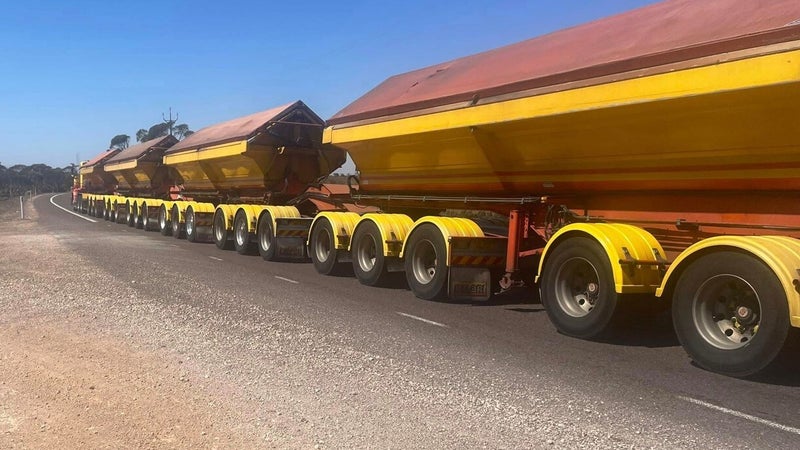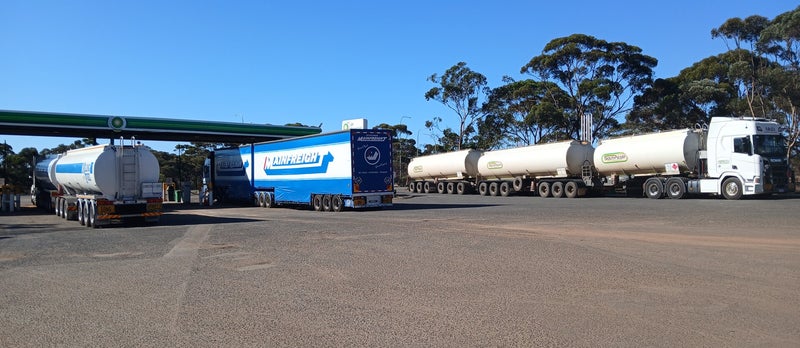Cycling Safety
There are no cycling paths on the Eyre highway and, in sections, there is no road shoulder. This is the main transport route and one of only two sealed roads connecting the east & west coasts of Australia. You will be riding among other vehicles and will need to remain constantly alert during your crossing.
Legally, drivers are required to give 1.5 metres when passing a cyclist on the Eyre highway. While the vast majority of drivers will try to give that room, slowing a 130 tonne road train from 100kmh is not easy. It's impossible to know if the driver about to pass will pass safely, so it's best for the rider to make sure they keep themselves safe, rather than rely on drivers.
This page details the steps I have taken to safely cross the Nullarbor 5 times.

How to stay safe while riding across the Nullarbor
There are many ways to stay safe while riding. It mostly comes down to being aware of your surroundings and taking actions to keep yourself safe.
Mirrors

My view is that at least one mirror is mandatory. It should be on the right hand side for best view of traffic from behind. It should be adjustable in case the sun is setting directly behind you and the mirror directs the sun into your eyes.
Check the mirror constantly to avoid being surprised. This is particularly important when riding into a headwind as the wind can make it almost impossible to hear the sound of a car approaching from behind
The quality of the view will depend largely on the road surface. If there are no cars behind, the left hand wheel track is smoothest and provides the best viewing. The road shoulder is often rough and reduces the available view. In places I've had to do a shoulder check before coming back onto the road as the shoulder was so rough, the mirror was unreliable.
Be seen! - Wear bright colours

Make it easy for drivers by making sure you are highyl visible. Bright and contrasting colours help. It is also a good idea to have hi-viz / reflective material on various parts of both the rider and the bicycle, particularly if riding at night. Research shows the up & down movement of the feet is something that helps quickly identify that the object ahead is a cyclist. Ankle bands that are a contrasting colour to the surrounding material will highlight this. It's why my black socks are over the tights, making the hi-viz yellow stand out more. Reflective tape on the cranks has a similar effect at night.
UHF Radio

Truck drivers and a growing number of caravan and car drivers use UHF radio to communicate. I used a UHF radio for the first time on my last crossing and now would never cross without one. Channel 40 is used by drivers on the Eyre highway.
When a truck is approaching from behind, get on the UHF and let them know you're ahead. They should spot you well beforehand, but it removes doubt and lets them know that you are prepared.
"Eastbound, this is the cyclist ahead. Road looks clear for a safe pass. If there's oncoming traffic, I'll get off the road." This gives them no excuse not to move out and pass safely. Still use your mirrors to make sure.
Water

Places to re-supply with water are up to 200km apart.
How much water you need will depend on you as an individual and the conditions at the time. I carry 4 litres of water in a crank tank and 3x600ml bottles of soft-drink. However, I've not done a crossing in summer, live in a tropical climate where riding in 30C+ is normal, and cover the distance between road houses every day. I've never had to make water last more than one day and I don't cook meals.
Your water needs may be significantly higher than. Other riders I know have carried 14 litres of water for the journey.
Left hand curves

Left hand curves create a line of sight problem. (Couldn't find a suitable picture)
If you are going around a left turn, vehicles approaching from behind may not see you until they are close behind due to roadside trees. You will also not see them until very late. For left hand curves, ride closer to the fog-line and be prepared to quickly move further left.
Right hand curves don't have the same issue, but be aware that the curve means you have to move your body position for the mirror to see what's coming around the corner toward you.
Video camera / Bicycle dashcam

A dashcam is becoming a standard item in most cars and is almost compulsory in trucks. You can also buy a bicycle specific camera to help keep the roads safe by allowing you to record and report close passes. If a driver decides to get vocal, ask them to smile for the camera. They usually get less vocal when they realise they are being filmed.
If a vehicle places you life in danger, the camera will record the incident. Best practice is to call out the registration number of the vehicle loudly, so it is recorded on the video. If using a bicycle computer you can hit lap reset or if the road is clear of traffic, ride in a circle across the road so it will appear on your ride records. That will give you the exact time and location of the incident, including GPS coordinates.
Report the incident to the police and follow-up with a request to know the outcome.
Road trains

Australia's road trains are unique. The largest you'll likely encounter crossing the Nullarbor are these 65 metre long trucks moving ore that are operating from mines. Most common trucks are the B-Doubles with just two trailers, although triples are also common.
Road trains move a huge amount of air, so be prepared for sudden gusts of wind as they pass. You definitely want the full 1.5 metre clearance when they pass.
The rear trailer can move around. Experienced road train drivers will change lanes well before reaching you. Road train rivers moving out to overtake late will cause greater movement of the back trailer. If a road train is not changing lanes to overtake, I'll be riding either well onto the shoulder or leaving the road completely.
Use multiple lights

Have multiple lights in case one stops working. I have two front & four tail lights. Front lights are used as required with a flashing light only used when there are cars / trucks coming out of rest areas etc to make sure they have seen me.
A flashing rear light operates whenever riding. A second light when riding at night, a third if there is fog and/or rain. The fourth is in case one fails. Try to have the lights on different flash patterns, not the same synchronised flashes.
Be wary of Google maps

When outside major cities in Australia, be very wary about using the cycling option in Google maps. The cycling option directs riders away from major roads. With the Eyre highway being the only sealed road crossing the Nullarbor, the cycling option directs people along dirt tracks adding over 200km to the trip.
If that's not bad enough, the route bypasses almost every roadhouse. Taking the recommended cycling route would leave the rider with no access to food, water or accommodation for over 800km.
If you take the recommended route, there will be virtually zero traffic. If anything goes wrong, you can't flag down a passing vehicle. Sticking to major roads in regional and remote areas of Australia is often the only viable option. Carefully research any cycling route recommended before starting your journey.
Road position

Ride where you feel the safest & most comfortable.
My strategy is to ride in different parts of the road, depending on traffic & conditions. When traffic is heavy, I'll stick to the the shoulder. If traffic is light, I'll ride on the smoothest part of the road, which is usually the left hand wheel track, about a metre in from the fog line. This provides the best view behind through your mirror.
When cars come from behind, I'll watch to see how they are going to pass me. If they change lanes, I stay on the left wheel track. If they are moving out, but not changing lanes, I'll wait until they have committed to moving out and then swing left to increase the passing distance. If the driver is not moving at all, I'll move onto the shoulder or leave the road completely.
Oncoming traffic is a sign to check for traffic behind. If there is both oncome traffic and something coming from behind, it's time to get onto the shoulder or off the road completely. Always check the mirror when you see oncoming traffic.
Wide loads

When a pilot vehicle passes you, it's time to take a break. Look for a place to pull well off the road and have a drink or something to eat. Behind the pilot vehicle will be a wide load. If you carry a UHF radio, tell them cyclist is well off the road waiting for wide load to pass. The pilot vehicle will have told the truck driver there's a cyclist ahead, the driver will appreciate knowing that you've left the road.
Radar

There is a growing number of bicycle radars that are available to riders. Connected to the seat-post, the radar sounds an alarm when it detects movement from behind. The headset shows an approximation of the vehicles from behind. Some of the more advanced ones include the speed of the vehicle that is approaching from behind and it's distance. The unit on the seat-post has a red light that starts to flash as it detects vehicles approaching from behind with that flashing increasing in speed as the vehicle gets closer.
Road trains
B-doubles and a triple road train at Norseman Roadhouse. This is what to expect too have passing you on a regular basis.
While you're at a roadhouse, take the opportunity to talk with truck & caravan drivers. Let them know what your safe cycling strategies are. Much of what is listed here has come from talking with truckies while crossing the paddock. The use of UHF radio to let them know you're out there is always appreciated.
